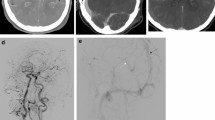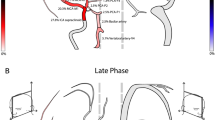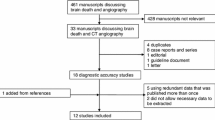Abstract
Background
The diagnosis of brain death is primarily clinical. Sometimes ancillary tests are needed.
Objective
This study compared sensitivity and interobserver agreement of the 10-, 7- and 4-point CT angiography scoring systems for the diagnosis of brain death in children.
Materials and methods
CT angiography examinations of 50 pediatric patients with a clinical diagnosis of brain death were evaluated according to 10-, 7- and 4-point scoring systems. Images were evaluated by two radiologists who considered the vessel opacification first in the arterial phase (A0–V50) and then in the venous phase (A0–V50). We evaluated interobserver agreement for the assessment of vessel opacification and diagnosis of brain death. We compared the differences among brain death diagnoses between children with craniotomy–craniectomy defects, open fontanelles and preserved bone integrity. We subdivided children into two groups according to age: ≤ 2 years and > 2 years. We calculated sensitivities according to age groups.
Results
Using the clinical exam as the reference standard, we found sensitivities for 10-, 7- and 4-point scoring systems to be 70%, 88% and 92% in the A0–V50 method and 40%, 82% and 82% in the A50–V50 method, respectively. Percentage agreement between readers was 78% for the 7-point scale using the A0–V50 method and more than 90% for other scoring systems for both the A0–V50 method and the A50–V50 method. The sensitivity was much lower in children with open anterior fontanelles compared to the groups with preserved bone integrity and with a craniotomy–craniectomy defect.
Conclusion
Just as in adult age groups, in children the 4-point scale appears to be more sensitive than the 10- and 7-point scales for CT angiography-based assessment of brain death. Because the scoring systems have similar sensitivities, they could be used as ancillary tests in pediatric cases.





Similar content being viewed by others
References
Rizvi T, Batchala P, Mukherjee S (2018) Brain death: diagnosis and imaging techniques. Semin Ultrasound CT MR 39:515–529
Quesnel C, Fulgencio J-P, Adrie C et al (2007) Limitations of computed tomographic angiography in the diagnosis of brain death. Intensive Care Med 33:2129–2135
Marchand AJ, Seguin P, Malledant Y et al (2016) Revised CT angiography venous score with consideration of infratentorial circulation value for diagnosing brain death. Ann Intensive Care 6:1–7
Şahin H, Pekçevik Y (2015) CT angiography as a confirmatory test in diagnosis of brain death: comparison between three scoring systems. Diagn Interv Radiol 21:177
Sawicki M, Bohatyrewicz R, Safranow K et al (2014) Computed tomographic angiography criteria in the diagnosis of brain death — comparison of sensitivity and interobserver reliability of different evaluation scales. Neuroradiology 56:609–620
Gastala J, Fattal D, Kirby PA et al (2019) Brain death: radiologic signs of a non-radiologic diagnosis. Clin Neurol Neurosurg 185:105465
Nakagawa TA, Ashwal S, Mathur M et al (2011) Guidelines for the determination of brain death in infants and children: an update of the 1987 task force recommendations. Crit Care Med 39:2139–2155
Garrett MP, Williamson RW, Bohl MA et al (2018) Computed tomography angiography as a confirmatory test for the diagnosis of brain death. J Neurosurg 128:639–644
Henderson N, McDonald MJ (2017) Ancillary studies in evaluating pediatric brain death. J Pediatr Intensive Care 6:234–239
Frampas E, Videcoq M, De Kerviler E et al (2009) CT angiography for brain death diagnosis. AJNR Am J Neuroradiol 30:1566–1570
Dupas B, Gayet-Delacroix M, Villers D et al (1998) Diagnosis of brain death using two-phase spiral CT. AJNR Am J Neuroradiol 19:641–647
Combes J-C, Chomel A, Ricolfi F et al (2007) Reliability of computed tomographic angiography in the diagnosis of brain death. Transplant Proc 39:16–20
Leclerc X, Taschner C, Vidal A et al (2006) The role of spiral CT for the assessment of the intracranial circulation in suspected brain-death. J Neuroradiol 33:90–95
Srairi M, Meluchova Z, Paoletti M et al (2020) Diagnostic accuracy of a revised computed tomography angiography score for brain death confirmation, combining supra-tentorial arteries and infra-tentorial veins. Eur J Radiol 130:109132
Akdogan AI, Pekcevik Y, Sahin H, Pekcevik R (2021) Assessment of cerebral circulatory arrest via CT angiography and CT perfusion in brain death confirmation. Korean J Radiol 22:395–404
No authors listed (1987) Report of special task force. Guidelines for the determination of brain death in children. American Academy of Pediatrics Task Force on Brain Death in Children. Pediatrics 80:298–300
Berenguer CM, Davis FE, Howington JU (2010) Brain death confirmation: comparison of computed tomographic angiography with nuclear medicine perfusion scan. J Trauma 68:553–559
Brasil S, Bor-Seng-Shu E, de-Lima-Oliveira M et al (2019) Computed tomography angiography accuracy in brain death diagnosis. J Neurosurg 27:1–9
Nunes DM, Maia ACM Jr, Boni RC, da Rocha A (2019) Impact of skull defects on the role of CTA for brain death confirmation. AJNR Am J Neuroradiol 40:1177–1183
Rieke A, Regli B, Mattle HP et al (2011) Computed tomography angiography (CTA) to prove circulatory arrest for the diagnosis of brain death in the context of organ transplantation. Swiss Med Wkly 141:w13261
Sawicki M, Sołek-Pastuszka J, Chamier-Ciemińska K et al (2019) Computed tomography perfusion is a useful adjunct to computed tomography angiography in the diagnosis of brain death. Clin Neuroradiol 29:101–108
Welschehold S, Kerz T, Boor S et al (2013) Computed tomographic angiography as a useful adjunct in the diagnosis of brain death. J Trauma Acute Care Surg 74:1279–1285
Shankar J, Vandorpe R (2013) CT perfusion for confirmation of brain death. AJNR Am J Neuroradiol 34:1175–1179
Welschehold S, Boor S, Reuland K et al (2012) Technical aids in the diagnosis of brain death: a comparison of SEP, AEP, EEG, TCD and CT angiography. Dtsch Arztebl Int 109:624–630
Yuzhong Z, Xuelin Z, Renmin C et al (2003) Diameter measurements of cerebral arteries on three-dimensional time-of-flight MR angiograms. Chinese J Radiol 37:394–398
Sawicki M, Bohatyrewicz R, Walecka A et al (2014) CT angiography in the diagnosis of brain death. Pol J Radiol 79:417–421
Dunn LT (2002) Raised intracranial pressure. J Neurol Neurosurg Psychiatry 73:i23–i27
Figaji AA (2017) Anatomical and physiological differences between children and adults relevant to traumatic brain injury and the implications for clinical assessment and care. Front Neurol 8:685
Author information
Authors and Affiliations
Corresponding author
Ethics declarations
Conflicts of interest
None
Additional information
Publisher's Note
Springer Nature remains neutral with regard to jurisdictional claims in published maps and institutional affiliations.
Rights and permissions
About this article
Cite this article
Almus, E., Bıyıklı, E., Yapıcı, Ö. et al. Brain death in children: is computed tomography angiography reliable as an ancillary test?. Pediatr Radiol 53, 131–141 (2023). https://doi.org/10.1007/s00247-022-05419-2
Received:
Revised:
Accepted:
Published:
Issue Date:
DOI: https://doi.org/10.1007/s00247-022-05419-2




